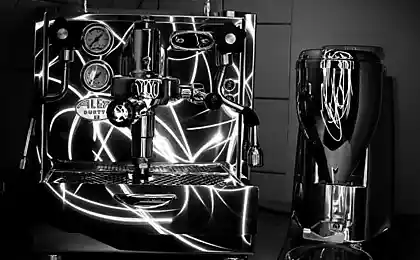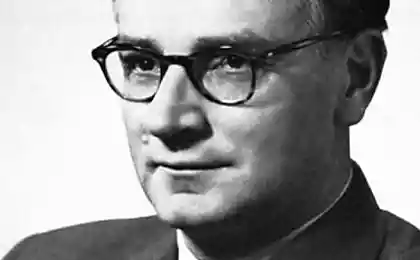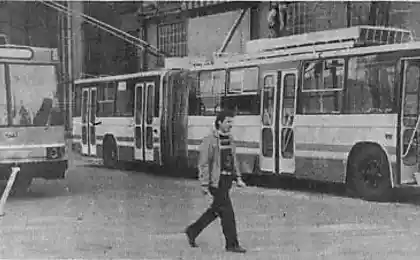Hello.
This publication, I would like to start a series of articles devoted to various technological developments of the past days.
After all, one way or another, but without them we would nebylo high technology.
For example, modern nuclear power plant is nothing but a nuclear steam engine. I>
Also in the articles will be referred to the names of great men, whose shoulders, held by modern science.
Historical information will be presented in the form of links / spoilers and comments.
I will try to be brief, pay more attention to the technical aspects, observe the chronological order and reliability.
And wanted to start with steam engines ...
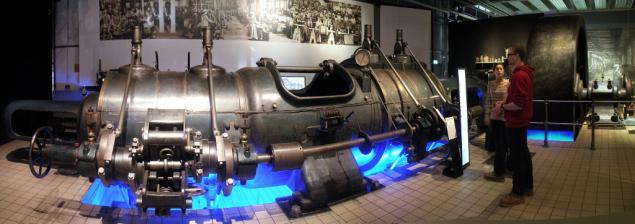
The horizontal stationary two-cylinder steam engine to drive transmissions factory. I>
The end of the XIX century. Exhibit at the Museum of Industrial Culture. Nuremberg i>
Steam Machine h4>
Паровая Machine - heat engine внешнего combustion, converts the energy of steam into mechanical work reciprocating piston, and then into a rotary motion of the shaft. i>
The first known device (Eolipil (or "ball Aeolus »), «Bath Heron "), driven by steam, has been described in Heron of Alexandria to first century
Hero of Alexandria - Great mechanic, programmer, cool showman and generally amusing guy Heron referred to as the greatest engineers in the history of mankind. He invented the first automatic doors, automatic puppet theater, vending machines, quick self-charging crossbow, a steam turbine, auto decoration, instrument for measuring the extent of roads (ancient odometer) and others. The first started to create programmable devices (shaft with a pin with a rope wound around it ).
In his treatise "pneumatics» (Πνευματικά) Heron described the various traps, cleverly arranged vessels, machines, driven by compressed air or steam.
Useful kinoshka how Geron, commissioned by the clergy "performed miracles" (worshipers rejoice ... and "pass the currency») «Technology etc. . civilizations. Hero of Alexandria. »
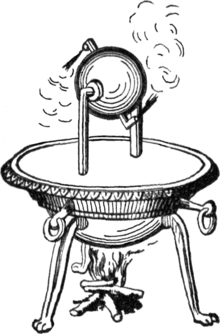

The steam from the bottom of the tank, but walked in the side tube into the cavity of the ball and breaking away from the nozzle fixed on the ball, forcing it to rotate. I>

Figures from the book «The Century of Inventions» (1655) Edward Somerset i>
The first steam turbine was invented much later in medieval Egypt, Turkish astronomer, physicist and engineer XVI century Такиюддином Al-Shami . He proposed method spits through the steam flow directed towards the blade wheels.
About Takiyuddine Muhammad ibn al-Shami Marouf al-Asadi In 1574, the Sultan of the Ottoman Empire Murad III Takiyuddina invited to Istanbul for the construction of the observatory [en]. With a huge knowledge in the craft business, Takiyuddin developed tools for astronomical observations, such as the huge armillary and mechanical watches, which were used to observe the comet in 1577. He also used the European Globe starry sky and a globe of the Earth, who were taken to the court of the Sultan as gifts. One of the most important of his works during his work at the observatory was the Tree of higher learning in the kingdom of rotating spheres, astronomical tables King of Kings (Sidrat al-muntah al-afkar fi malkūt al-falak al-dawār- al-zij al-Shāhinshāhi). This work is the result of astronomical observations, which were made in Egypt and Istanbul in order to complement the work of Ulugbek "Zidj al-Sultani." The first forty pages of work are computing, the story of the astronomical clock and information about the three eclipses, which he observed in Cairo and Istanbul. According to some sources that era Takiyuddina method to calculate the coordinates of stars was more accurate than the one that was used Nicolaus Copernicus and Tycho Brahe.

This illustration only describes the principle i>
Salomon de Caus , in his work « Les Raisons des Forces Mouvantes avec Diverses Machines » ( 1615 ), described the car based on the vapor pressure.
Here, everything that I could find in this work (as well as in this ), Related to the theme:
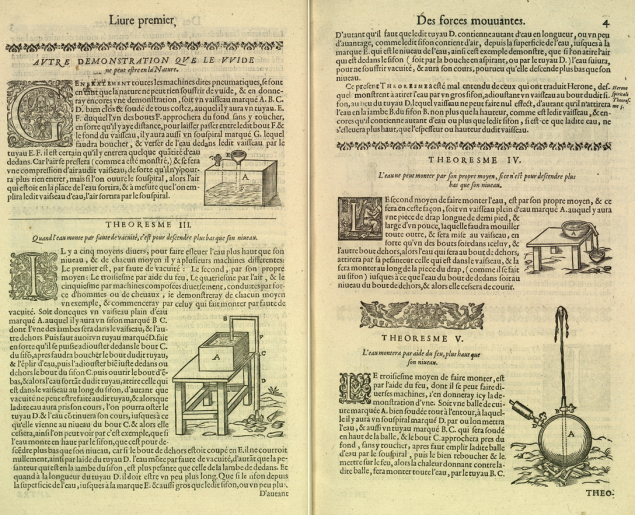
The ball standing on the fire, apparently associated with a vapor pressure ...

Salomon de Caus surrounded their devices ... i>
In his writings, Salomon de Caus pays much attention ustroistva working on the principle of & quot; водяных mills & quot ;.
Here you can read here ... i>
Italian engineer Giovanni Branca , to 1629 suggested ipolzovat pairs to rotate the cylindrical anchoring device which in turn has raised and released a pair of pestles in mortars.
Giovanni Branca Giovanni Branca (Giovanni Branca, 22.04.1571 - 24.01.1645) - Italian engineer and architect, best known for creating one of the first versions of the steam engine.
Giovanni Branca in his life made a lot of interesting inventions; a number of his works he dedicated to the governor of the city of Loreto (Loreto). Later he developed a collection of diagrams and drawings was published as a book, 'Le Machine'; included in this book of 63 etchings with descriptions in Italian and Latin. In many ways the book Branca has become a typical example of a popular genre at the time 'theater machine' (theater of machines), popular in the 15th century and is famous thanks to the book by Jacques Besson (Jacques Besson) 'Theatrum Instrumentorum'. Particularly good specimen of the genre book called Giovanni was difficult - if most of the books in this area traditionally very, very good to illustrate the book Branca was only a few frankly weak prints. It should also be noted that Branca honestly admitted that most of the described devices they personally have not tried to build and are the work of some is only indirectly.
In 1629 th saw the light of another work of Giovanni Branca, 'Manuale d'Architettura'. This book was devoted to various practical aspects of the building industry; for its time management it was quite helpful and informative - some sources say that the difficulty Branca actively used by many architects of that time.


The book «The Century of Inventions» , упоминается about this device ... i>
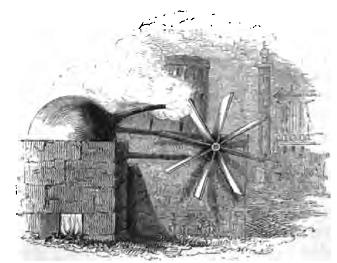
Most of the steam dissipated in an empty ... i>
( The following paragraph without proof, the network is the same kopipasta
I>)
Around the same time, the Spanish engineer Yeronimo Ayans de Beaumont created a steam engine with a cylinder - this mechanism has had some influence on developments in the field of improvement of steam engines.
Disk imaging of the man I did not find, if someone knows something, please give a link. I>
In 1655 Edward Somerset in his book, «The Century of Inventions » described the basic principle of steam engines and the range of their application. The castle Раглан, he established a device for lifting water on the wall of the great tower.
Castle 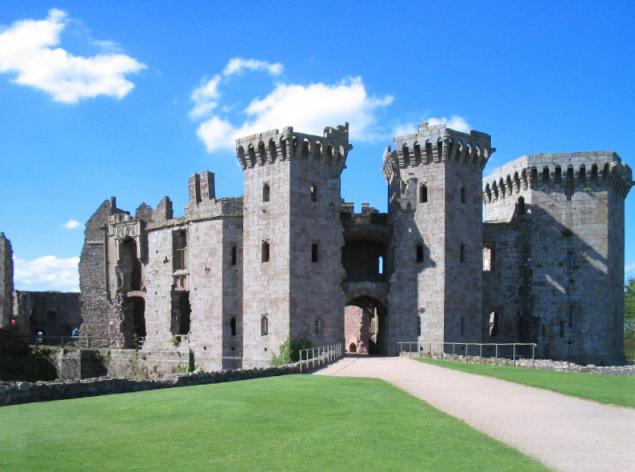
Back in the 19th century could be seen going into the wall where the car was located ...
I>
Ferdinand Verbiest credited with creating a 1670s years , the world's first (kind of like a toy) paromobiley.
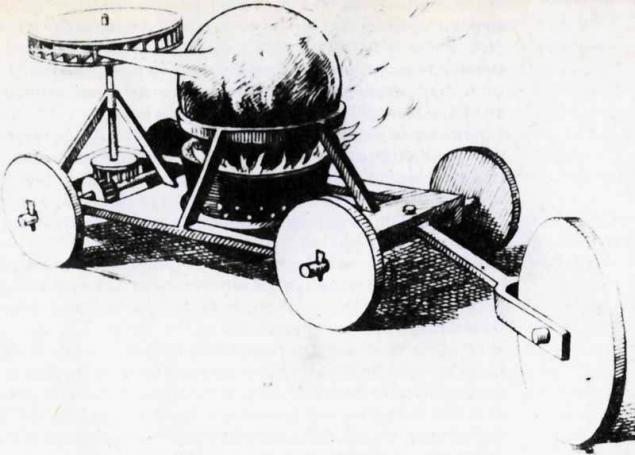
Unacknowledged information i>
Isaac Newton also did not remain indifferent, that's his view of the "reactive" paromobil:
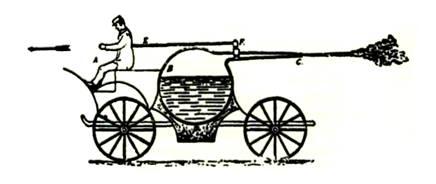
There is only a drawing or sketch, if you like i>
The next step in the development of steam engines, was to create a Denis Papin in 1680-1690 year (data flow)," piston "of the steam engine, which performed useful work due to heat and steam condensation. It was a completely new design of the steam engine. The design of the steam engine (piston and cylinder) Denis Papin prompted Leibniz.
About Denis Papin Papin was born in the French town of Blois in 1647. At the University of Angers, he studied medicine and received his doctorate. But the doctor did not Papen. In many ways, his fate predetermined meeting with the Dutch physicist Huygens, whose influence Papen began to study physics and mechanics. In 1688 he published with his constructive amendments description Huygens presented to the Paris Academy of Sciences of the project in the form of a powder engine cylinder and piston.
Papin also proposed the construction of a centrifugal pump designed for glass melting furnace, a steam wagon and submarine invented the pressure cooker and a few machines for lifting water.


The water in the cylinder at a heating turned to steam and move the piston up and vapor condensation was evacuated space and atmospheric pressure has moved the piston down.
Engine Papen poorly performing useful work, because he could not carry out a continuous action. To make the machine work, it was necessary to manipulate the rod-valve and stop, move the source of the flame and cool the cylinder with water. I>
Denis Papin is considered to be the inventor of the steam boiler, thus paved the way to the Newcomen steam engine. (See below.)
2 July 1698 English engineer Thomas Savery , received a patent for the invention of" fire engine "designed to pump water from mines .
Machine north - this steam pump, not the engine: it was not a cylinder with a piston, which in its move would lead to something in motion.
Most importantly in this device was that the steam for the pump, formed in a separate pot.
It happened so. The boiler, which is continuously stoked formed pairs. Opening the valve on the pipe, steam admitted to the pump reservoir. He withdrew from the two pipes: one (suction) fell into the shaft, the other (injection) was held in the gutter.
When the tank allowed couples he began to push the existing water in it for the discharge pipe in the gutter. Then, the steam supply was interrupted and a special tube admitted into the cold water tank. Steam was condensed, turning into the water and took a small amount, that is formed in the tank vacuum. Water is forced out of the mine atmospheric pressure, is sent to the suction pipe in the "empty" tank.
Pump Severi was a thin, consume a lot of fuel and worked intermittently. Nevertheless, setting the North helped inventors understand that in steam engines should use steam from a separate boiler.
little help Presumably, the very first "fire engine" Thomas Severi set mine Wil Thief (Wheal Vor) on the south coast of Cornwall, near the village of Karlin (Carleen), located about 2 miles north-west from Helstona (Helston).
In 1717-18, the "fire engine" by Tsar Peter I was set in St. Petersburg to supply water to about 50 fountains of the Summer Garden. Led the manufacturing and installation of Jean Theophile Dezagule Frenchman by birth, became a priest fairly high rank in England and head of the first English Masonic Lodge. Here is how it writes itself Dezagule:
"Since 1717 or 1718, I built seven advanced fire engines. The first - for the late King Peter the Great, for his garden in St. Petersburg. »
Machine to lift water to a height of 3 m above the ground. Her performance was 3 barrels per minute.
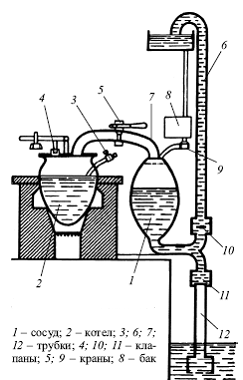
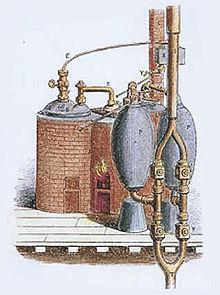
When the tap opening 5 from boiler steam 2 is supplied into the vessel 1, driving the water out through the pipe 6. The valve 10 in this case is open and valve 11 closed. At the end of the injection valve 5 closed and the valve 9 through the vessel 1 is fed in cold water. The vapor in the vessel 1 is cooled, condensed, and the pressure dropped, sucking back the water in the tube 12. The valve 11 thus opened, and the valve 10 is closed. I>
a widespread these devices are not received. B>
The coup brought the same technique in the Piston i> steam engines h4>
By the beginning of XVIII century in England there were conditions under which the establishment of industrial machinery was profitable. In 1705 Thomas Newcomen (combining ideas Thomas Savery and Denis Papin) built < i> piston i> steam pump, experiments to improve which lasted about ten years, until he began to work properly.
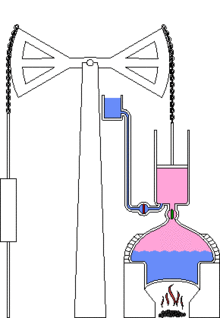

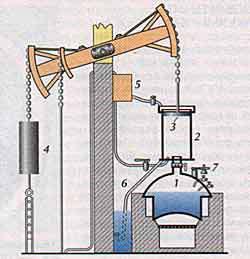
The main part of it was a piston, balanced weight and move in a large vertical cylinder (2). The pressure of the steam supplied from the boiler to the cylinder (1) raise the piston. Injection of cold water from the reservoir (5) and sedimented pairs created in the vacuum cylinder. Atmospheric pressure lowers the piston down. The cooling water and condensed steam is discharged from the cylinder through a pipe (6), and excess steam from the boiler - via a safety valve (7). Thereafter, the engine was again ready for the next steam injection.
The main drawback of machines consists in that the working cylinder it was at the same time, and a condenser. Because of this, had to turn it cool, then heat the cylinder.
(Oil станок-качалка works the same) i>
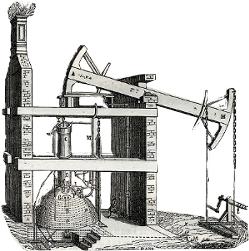

Thus, the Newcomen engine was more пароатмосферной, than pure steam, as the stroke she carried no vapor pressure, namely atmospheric pressure.
Newcomen pumps have been used in England and other European countries for pumping water from deep flooded mines. By 1800, there were 1,454 cars proizvedino Newcomen, many of which remained in operation until the beginning of XX century.
With some modifications, the machine Newcomen for 50 years were the only mechanisms that are suitable for industrial use.
In 1763 Russian inventor Ivan Polzunov , working as a mechanic in the Altai mining and metallurgical plants, created the first Russian steam engine and the world's first two-cylinder steam engine.
Crawlers upgraded machine Newcomen (to ensure continuous operation he employed two cylinders instead of one), and suggested using it for ghosts in motion мехов smelters.

The principle of operation is similar to the Newcomen machine.
When one cylinder filled with steam, injected water, condensed steam and vacuum was created in the cylinder. Under the influence of atmospheric pressure piston starts to descend and at this moment, in another cylinder in the lower position, steam begins to flow, and he began to move up.
Supply of water and steam into the cylinders was fully automated. The piston rod of the steam engine were connected by a chain. The chain passes through the upper pulley and the motion of the steam cylinder, pulley, too, had to move. The movement of the pulley in turn, through the chain is driven by special rods, whose main purpose was to control the movement of the pendulum crescent. It crescent pendulum ruled alternately feed water and steam in the steam cylinder.
(Machine Polzunova as Newcomen engine was paroatmosfernoy)
I>

The model steam engine II Polzunova made to original specifications in the 1820s. Local History Museum Barnaul. I>
The sad Help In Russia at that time, steam engines were not used and all information Crawlers got from the book "A detailed instruction ore case" (1760) authored by IA Schlatter ., in which described the Newcomen steam engine.
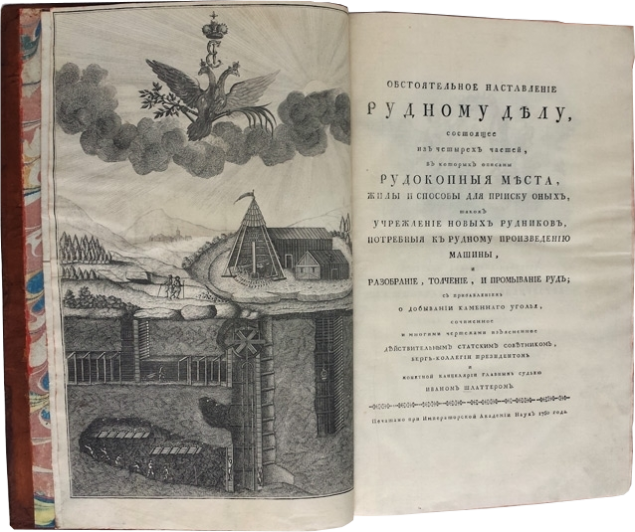
About the project was reported to the empress Екатерине Second . She ordered to produce IIPolzunov in "Mechanicus with the rank and title of captain-lieutenant engineering" award 400 rubles, and if possible, send to study in St. Petersburg. By May 1766 the construction was largely completed. But on May 27, a few months before the start of the machine, slides died. The machine began to work without him and worked regularly for 43 days. However, occurred when there was no one test to correct deficiencies, and the car, finally, got up from the boiler leaks. Her abandoned. In the future, as prescribed by the rulers of the Altai factories polzunovskaya machine factory, where she worked as the car was broken down. The remaining ruins preserved the popular name "Polzunovskoe ashes».
Covershit is a real revolution in this field, was destined to Scottish engineer and inventor James Watt. B>
In 1765 James Watt invented the steam engine with a capacitor. However, the car itself was founded only 10 years later (due to lack of funding). I>
In 1769 he received a patent for this invention.




























